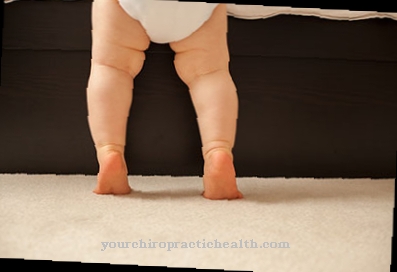The Pulmonary fibrosis is a lung disease that can have many different causes. The lungs become stiff due to scarring. Breathing difficulties and reduced resilience are typical. Pulmonary fibrosis cannot be cured, only relieved.
What is pulmonary fibrosis?

The Pulmonary fibrosis is a chronic inflammation of the lungs, which usually starts with inflammation of the alveoli. This inflammation leads to the increased formation of connective tissue in the lungs, which causes the lung tissue to scar and become stiff.
As a result, the extensibility and volume of the lungs are greatly reduced, and gas exchange in the lungs is severely impaired. Not only is it more difficult to breathe itself, the scarring also makes it more difficult for the oxygen to get into the blood and increases the difficulty of breathing.
The longer the pulmonary fibrosis lasts, the harder it is for the heart. If there is no cause for the pulmonary fibrosis, the doctor speaks of idiopathic pulmonary fibrosis.
causes
The Pulmonary fibrosis can have different causes, but the body's own collagen always forms in an uncontrolled manner. Collagen is almost inextensible and is the most important protein found everywhere in the human body. It is one of the most important components of human connective tissue and is therefore found primarily in bones, teeth, cartilage, tendons, ligaments and of course the skin.
The diseases that can cause pulmonary fibrosis include, for example, inflammatory processes. Circulatory disorders, various infections by viruses, bacteria or fungi, systemic diseases and poisons can also cause pulmonary fibrosis.
A very important cause in the past few years was asbestos, which was used everywhere in the construction industry. Long-term inhalation of asbestos fibers has been shown to lead to inflammatory reactions and the development of pulmonary fibrosis. In half of the cases, however, the cause is also unknown.
Symptoms, ailments & signs
Fibrosis of the lungs can go undetected for years. The first symptoms only appear as soon as the organ is already severely damaged. Symptoms include shortness of breath and dry cough, although the breathing difficulties initially only occur during physical exertion. Only at an advanced stage do those affected suffer from shortness of breath even when at rest.
Accompanying this can be noticed when breathing in an oppressive feeling of tightness. In individual cases breathing is blocked and the lungs only open again after a few breaths. The breathing difficulties eventually lead to an insufficient supply of oxygen to the body. This can be recognized by the blue-colored fingers and the so-called drumstick fingers, which are expressed by distended finger extremities.
Signs of the disease also include conspicuously arched fingernails and paleness. People with pulmonary fibrosis suffer excessively from infections of the respiratory tract and lungs. In the worst case, pneumonia can occur, which is announced by pain when breathing and an increasing feeling of illness.
In addition, fibrosis of the lungs can cause muscle and joint pain, fatigue, tiredness, fever, loss of appetite and weight loss. In advanced stages, pulmonary hypertension often develops, which can lead to heart damage and water retention in the abdomen.
Diagnosis & course
Patient with Pulmonary fibrosis often suffer from coughing, tiredness and severely limited resilience. A first symptom is water retention in the lungs (pulmonary edema), as the walls of the alveoli are thickened. The gas exchange between blood and lungs is impeded.
In the beginning there is shortness of breath under exertion, in an advanced stage the shortness of breath also occurs at rest. The respiratory rate is increased as the patient has to inhale against resistance.
If the pulmonary fibrosis is more advanced, the skin also changes due to the lack of oxygen. The skin and mucous membranes turn bluish, the fingernails and toenails thicken in the shape of a piston, are thickened and rounder than normal fingernails or toenails (drumstick fingers) and bulge like a watch glass (watch glass nails). In general, these are signs of a prolonged lack of oxygen supply to the tissue.
The auscultatory findings (i.e. the stethoscope) can provide a first indication of pulmonary fibrosis. In addition to questioning the patient, the examination also includes lung function tests and x-rays. The diagnosis is confirmed by a lung specimen during which the doctor takes samples of the lung tissue.
Complications
In the worst case, pulmonary fibrosis can lead to patient death. With early treatment, however, the restrictions and complaints can be treated and resolved relatively well. In most cases, those affected suffer from shortness of breath and also from shortness of breath. The lungs can no longer expand in the usual way and thus no longer absorb enough oxygen.
Those affected feel exhausted and tired as a result. There is also a reduced resilience, so that the patients no longer actively participate in their lives. Furthermore, a strong cough occurs, which can lead to various restrictions in the patient's everyday life. In general, the quality of life of the person affected is considerably restricted and reduced by the pulmonary fibrosis.
Pulmonary fibrosis can be treated with a variety of drugs. There are no further complications. However, this treatment does not always lead to a positive course of the disease. It is not uncommon for those affected to have to rely on a lung transplant in order to survive.In many cases, only slowing the progression of pulmonary fibrosis is possible.
When should you go to the doctor?
If you experience shortness of breath or difficulty breathing, you should consult a doctor. If you have a persistent cough or a dry cough, you need to see a doctor. Initially, the disease usually remains unnoticed because the patient is symptom-free for a long time. This means that the symptoms only appear at an advanced stage of the disease and this should then be classified as soon as possible. If the person concerned suffers from anxiety due to restricted breathing, a doctor should be consulted.
If breathing is blocked or if breathing is irregular, a doctor is needed. Consult a doctor if there are signs such as tiredness, fatigue, exhaustion or rapid fatigue. If the usual services can no longer be provided, a comprehensive examination is advisable. If there is pain in the joints, bones, or muscles, there is cause for concern. A decrease in body weight, the formation of swellings or irregularities in the heart rhythm must be checked and clarified by a specialist.
If water retention develops, abnormal skin complexion or apathy occurs, a doctor's visit is necessary. Discoloration of the fingers, paleness of the skin, or impaired blood flow in the limbs are signs that should be discussed with a doctor.
Treatment & Therapy
The Pulmonary fibrosis cannot be cured at the current state of medical research. Scarred tissue no longer recedes. Therefore, the main goal of therapy is to stop or at least slow down the expansion of the scarring and stiffening of the lungs.
If a poison is the cause of the fibrosis, the patient must of course strictly avoid the triggering pollutant immediately.
In the case of inflammatory processes, the doctor often prescribes cortisone preparations and immunosuppressants, i.e. drugs that inhibit the immune system and have a positive effect on inflammatory processes. Depending on the severity and stage of the disease, the administration of oxygen may also be necessary.
If the pulmonary fibrosis is severe and drug treatment is no longer possible, a lung transplant is indicated.
A prognosis of the success of the therapy is difficult because there are many different triggers for pulmonary fibrosis and the disease can therefore take very different courses.
You can find your medication here
➔ Medication for shortness of breath and lung problemsOutlook & forecast
If pulmonary fibrosis has been diagnosed, no specific statements can be made about a general prognosis. The reason for this is the fact that the course of the disease is not uniform and the clinical picture can express itself very complex.
In certain cases it is possible that pulmonary fibrosis has little or no effect on the patient's life expectancy. In other cases, the disease can also progress quickly. If it is pulmonary fibrosis that occurs for no apparent cause, the prognosis is usually poor.
In general, it can be said that pulmonary fibrosis cannot be cured. This means that the scarred lung tissue does not recover. Pulmonary fibrosis is classified as an extremely serious condition and in many cases leads to death within three to four years of diagnosis. It is also not possible to stop the disease from progressing.
The actual prognosis depends on a large number of factors. An early start of treatment has a decisive influence. However, the existing damage to the lungs and the speed at which the disease progresses also have an impact on the success of the treatment. If further complications such as infections or heart failure occur, the prognosis can worsen.
In order to have a positive influence on the prognosis and to avoid complications, it is necessary for the patient to adapt his or her lifestyle according to the advice of the attending physician.
prevention
The only means of prevention Pulmonary fibrosis is to prevent the triggering causes. Contact with toxic substances is to be avoided and, especially in professions in which a worker comes into contact with such substances, the employer must absolutely pay attention to protective measures.
Aftercare
In the worst case, pulmonary fibrosis can lead to the death of those affected. If they undergo early treatment, the symptoms and restrictions can often be treated well. Those affected primarily suffer from shortness of breath and shortness of breath, so physical exertion should be avoided as far as possible.
The lungs can no longer expand as usual and therefore cannot absorb sufficient oxygen. Those affected suffer from permanent tiredness and exhaustion and should take it easy as far as possible. The lower resilience can lead to various impairments in everyday life. The quality of life of those affected is usually significantly reduced by the disease.
Those affected are permanently dependent on the help and support of relatives. This can lead to depression and other mental illnesses. The disease can be treated with the help of various drugs. Long-term medical care can have a lasting positive effect on the progression of lung fibrosis.
You can do that yourself
Progressive pulmonary fibrosis is accompanied by increasingly difficult inhalation because the fibrosis makes the lungs more inelastic and the chest muscles have to exert more force to expand the lungs for the process of inhalation. This in turn often prompts those affected to breathe shallowly and intuitively to take physical rest. As it turns out, such behavior is counterproductive.
As an adjustment in everyday life and as a self-help measure, the goal can be seen to do sports as far as possible, parallel to a drug treatment that aims to stop the fibrosis in the course of the process. It is ideal if there is the possibility of doing the sport in a lung sport group under medical supervision. The advantages of physical activity are an improvement in basic fitness and thus an improvement in well-being. In addition, the chest muscles are trained and strengthened so that breathing is apparently easier during the rest phase.
Another self-help measure consists of targeted breathing exercises, which aim to make better use of the existing capacity of the lungs and to train and strengthen the muscles required for breathing. Long-term oxygen therapy is now advised against in the case of pulmonary fibrosis, because there is a risk that the increased oxygen supply will promote so-called reactive oxygen species. This could accelerate the progression of pulmonary fibrosis.

.jpg)



.jpg)





















